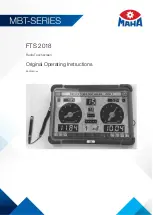
8
USB 7706
Compressor Dual Channel
2. EXPANDER/GATE SECTION
The main task of the Expander/gate is to "inaudibly" eliminate undesirable background noise from the usable signal. This
assumes that there is a slight level difference between the usable signal and noise floor, in order to be able to define the
operating threshold of the Expander/Gate. At the same time, the Expander/gate must respond very quickly (have a very
fast attack time) so that the signal's leading edge remains unaltered.
Because the Expander/gate of the COMPRESSOR is self-adapting to the program material. it will be possible to obtain more
satisfactory results with the new IRC (Interactive Ratio Control) circuit than with conventional expanders. When expansion
occurs there are no common side effects due to the extremely smooth and unobtrusive action of the circuit.
When the Expander starts to operate, the INAUDIBLE LED INDICATORS will illuminate. For a signal above the threshold
value, the "+" LED lights. The "-" LED lights when expansion occurs. because the expansion initially starts very smoothly.
You may find yourself in a situation where this LED illuminates with little or no perceived gain reduction occurring.
2.1 Controlling Leakage In The Studio
Expander/gates are most commonly used to suppress undesirable leakage of sound from one track to another during recor-
ding or playback. They are usually used when recording drum kits, where the mics are very close to each other. High volu-
me levels of individual instruments often cause considerable leakage onto all the adjacent mics and results in conflicting
frequency and phase coherence problems, as well as unspecified sounds ("comb" filter effects). It is vitally important that
every instrument is recorded into a separate mic and that each mic is individually gated.
Patch the COMPRESSOR into a snare drum channel for example and adjust it so that triggering only occurs on snare hits.
Each mic should be set to its maximum operating level, monitored and the THRESHOLD level set so the each snare hit
sounds acoustically clean and separate, as though it was played on its own.
The optimum use of the Expander/gate depends principally on microphone technique. Be particularly careful, when high
frequency instruments are located to the side or rear of a Cardioid microphone. Most cardioids exhibit a sharply rising off-
axis response characteristic at higher frequencies. If there is only a 2 or 3 dB difference between the on-axis and off-axis
response in the 5 to 10KHz region, cymbals may leak excessively into the tom mics and you may have hi-hat spilling all
over the snare mic.
Make full use of the directional characteristic of the mics, to acoustically exclude all other instruments as much as possible.
Make sure that you do everything possible to achieve source separation with good microphone technique. Otherwise the
Expander/gate is not able to undertake clear acoustic separation.
Sometimes, it is necessary to prevent the Expander/gate from responding to low frequencies (rumbles etc.), especially if
a singer is moving the microphone around on a mic stand. More information about this topic is in section E.2 " Using an
Equalizer in the Sidechain Path".
2.2 Initial Settings For the Expander/Gate Section
Controls:
Settings:
THRESHOLD control:
-70dS
Begin with very low threshold levels, so that the signal can pass through the unit unaffected. Now turn the control clockwi-
se until all unwanted noise is removed and only the sound of the desired instrument can be heard.
If the control is set correctly, the drum sounds will be "dry", "sharp" and clearly defined. If you do not have enough mics
to record each instrument separately, try to create subgroups: put the snare and mid-toms together, and group the side-
toms, bass drum and cymbals together with the help of a mixing console. The aim is to set up the Expander/gate and to
position the group mics so that each strike on an instrument opens a specific mic and so only that instrument is recorded,
while the other mics remain "muted".
© US Blaster Europe BV









































